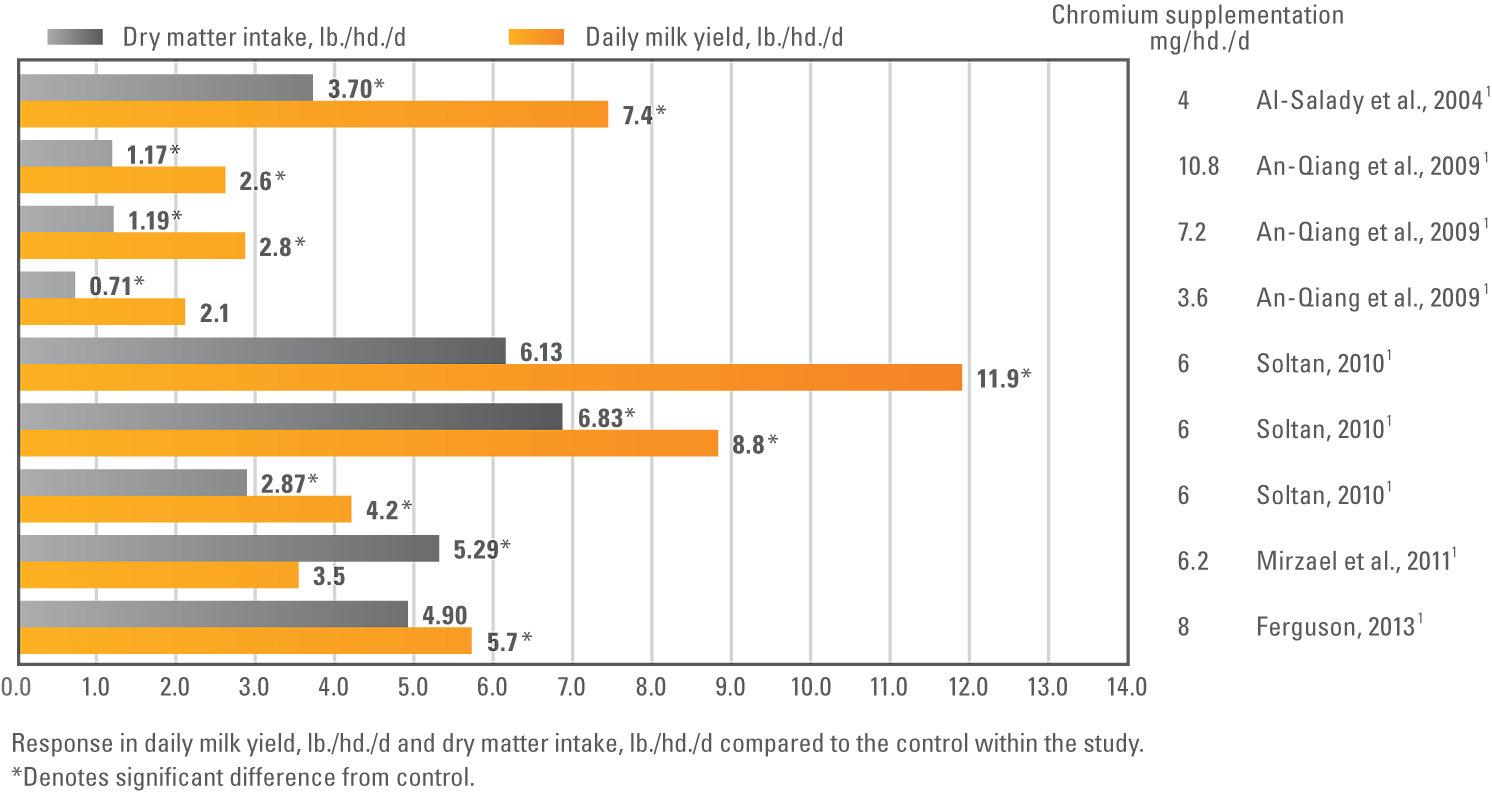Did you know?
- In the U.S., approximately $1 billion is lost annually as a result of poor performance of dairy cows during periods of heat stress.1,2
- Milk yield starts to decrease at a temperature humidity index of 68 according to recent studies.3,4
You are viewing United States
Prepare Your Cows to Beat the Heat


Chromium studies have proven the important role that chromium can play to help your cows' alleviate the negative effects of heat stress.
Chromium has been shown to:
Data dive:
Impact of supplemental chromium on milk yield during heat stress
Studies have shown that supplementing chromium during heat stress events can help reduce the negative effects on milk yield.

Cows fed supplemental chromium during heat stress conditions significantly improved both milk yield and dry matter intake.
Data dive:
Effects of chromium supplementation on dairy cattle (meta-analysis)
A thorough meta-analysis of 16 peer-reviewed scientific journal articles evaluated the impact of chromium supplementation in dairy cattle.

98.5% probability that DMI will increase by at least 1 lb/hd/d and 99% probability that milk yield will increase by at least 1 lb/hd/d.
KemTRACE® Chromium — the first product of its kind on the market — is a water soluble, highly bioavailable, organic source of chromium propionate that helps stabilize insulin receptors in cattle. This improves glucose utilization for increased energy and proper cell function, resulting in better immunity.
KemTRACE Chromium is supported by more than 20 years of Kemin research and is the only U.S. Food and Drug Administration-reviewed form of chromium propionate. See the KemTRACE Chromium mode of action at work.

Benefits beyond combating heat stress. To further prove the benefits of chromium supplementation, we conducted a thorough meta-analysis of 16 peer-reviewed scientific journals evaluating the benefits of chromium in dairy cows. The numbers speak for themselves. Dive deeper into the full meta-analysis.







Heat Stress Biology: Practical Management and Nutritional Strategies
There are a variety of situations in an animal's life when nutrient utilization is re-prioritized from productive towards agriculturally unproductive purposes. Two well-known examples that markedly reduce production are heat stress and ketosis. Decreased feed intake, experienced during both diseases, is unable to fully explain decreases in productivity. Additionally, both diseases are characterized by negative energy balance, body weight loss, inflammation and hepatic steatosis. While the metabolism of ketosis and heat stress have been thoroughly studied for the last 40 years, the initial insult in the cascade of events ultimately reducing productivity in both heat stressed and ketotic cows has not been identified. The focus of the presentation is to review practical management strategies that can be used to help mitigate the impact of heat stress.
Effects of Heat Stress on Gut Health and Immune System Nutrient Requirements
Heat stress and ketosis reduce efficiency. Decreased feed intake experienced during both situations is unable to fully explain the suboptimal productivity. Heat stress and ketosis affect herds of all sizes and almost every dairy region of the U.S. Dr. Baumgard hypothesizes the common etiological origin of both metabolic disorders as "leaky gut." Leaky gut and the resulting endotoxin infiltration alter nutrient partitioning and is a causative agent in metabolic disruption during heat stress and ketosis. Identifying dietary approaches that can improve gut barrier dysfunction is paramount in developing nutritional strategies aimed at improving intestinal health.
References
1Fuquay et al., 1981. J. Anim. Sci. 52:164-174.
2Kadzere et al., 2002. Livest. Prod. Sci., 77(1):59-91.
3West et al., 2003. J. Dairy Sci. 86(6):2131-2144.
4St-Pierre, N. R. 2003. J. Dairy Sci. 86:E52-E77.
5Collier et al., 1982. J. Dairy Sci. 65:2213-2227.
6Collier, R. J., D. K. Beede, W. W. Thatcher, L. A. Israel, and C. J. Wilcox. 1982. J. Dairy Sci. 65(11):2213-2227.
7Bernabucci, U., N. Lacetera, L. H. Baumgard, R. P. Rhoads, B. Ronchi, and A. Nardone. 2010. Animal. 4(7):1167-1183.
8Wheelock, J. B., R. P. Rhoads, M. J. Vanbaale, S. R. Sanders, and L. H. Baumgard. 2010. J. Dairy Sci. 93:644-655.
9Mertz, W. 1992. Biol. Trace Elem. Res. 32:3-8.
10Kemin Internal Document, 15-00066.
11Chang, X., and D. N. Mowat. 1992. J. Anim. Sci. 70:559.
12Moonsie-Shageer, S., and D. N. Mowat. 1993. J. Anim. Sci. 71:232.
13Burton, J. L., B. J. Nonnecke, T. H. Elsasser, B. A. Mallard, W. Z. Yang, and D. N. Mowat. 1995b. Vet. Immunol. Immunopathol. 49:29.
14Kemin Internal Document, 14-00015.
© Kemin Industries, Inc. and its group of companies All rights reserved. ® ™ Trademarks of Kemin Industries, Inc., USA
Certain statements may not be applicable in all geographical regions. Product labeling and associated claims may differ based upon government requirements.



